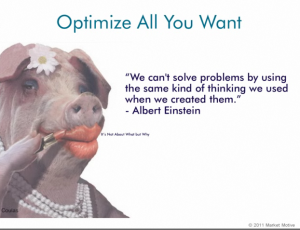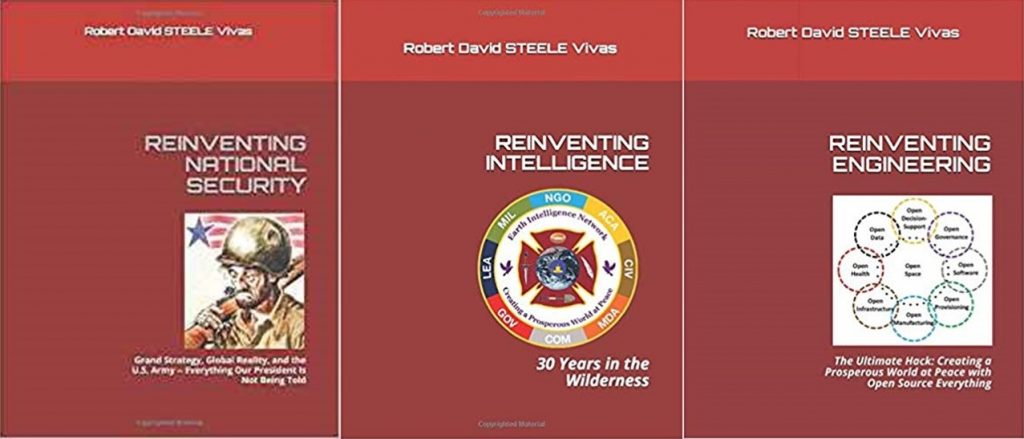
phi·los·o·phy
the study of the fundamental nature of knowledge, reality, and existence.
SHORT URL: http://tinyurl.com/steele-philosophy
I was asked recently to outline my “philosophy of intelligence” briefly, conversationally. What a wonderful challenge. Below is my fifteen minute answer using an outline that has been on my mind for some time, augmented by some graphics and a few additional sentences completing some of the thoughts.
Each morning the commander or civilian deccider should be asked:
- What would you have liked to know yesterday that we failed to tell you?
- What do you need to know about today that you have not mentioned before?
- What do you need to know in the future that you have not already mentioned?
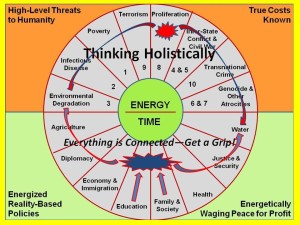
The Purpose of Intelligence
The purpose of intelligence is to provide a mix of encyclopedic information and warning including atmospherics, and decision-support — explicit answers to specific questions from the commander and their senior staff. Intelligence is a form of adult education on the fly, mission-centric decision-support, and acquisition-centric research.
Hence, the vast majority of what we do today — technical collection that is not processed, generic “intelligence” reports that do not address specific questions from specific customers — is not intelligence, merely classified information.
Worse, we are failing to provide intelligence with integrity relevant to grand strategy tailored to defeat all threats, harmonize all policies, guide acquisition and reduce all costs, and produce a safe and prosperous nation “with liberty and justice for all.” Intelligence should be but is not at this time “root.”
Holistic analytics and true cost economics are serious terms that are neither understood nor practiced within the current intelligence system. The new process does require respect for the old process that integrates requirements definition, collection management, all-source collection, processing, and analysis, extended to provide evaluated accurate analytics (not just information) helpful to all branches of government at all levels. Done right, intelligence should be the “driver” for an evidence-based economy and society, with education-intelligence-research as one seamless web of knowledge, understanding, and wisdom — this creates a Smart Nation.
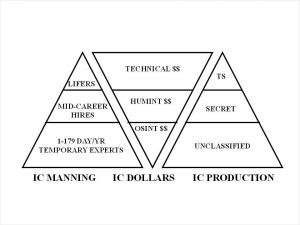
The Nature of Intelligence
Intelligence — decision-support (inclusive of atmospherics and warning) — demands integrity in all respects, starting with respect for the Constitution and an absolute commitment to never lie to Congress, the Executive, or the public.
Roughly 80% of what we need to know can be acquired using open sources and methods that are both inexpensive and easily shareable with others.
Roughly 20% of what we need to know demands secret sources and methods because our most ruthless adversaries — including bankers and secret societies as well as hostile nations and criminal networks — are best stymied if we achieve advance understanding.
Covert Operations (regime change, drone assassinations, rendition & torture, media influence operations, agents of influence mis-leading their host organizations) are not part of 21st Century intelligence. Covert Operations are acts of war that demand both Congressional authority, and engagement of Special Operations Forces (SOF).
Counterintelligence has two sides: offensive counterintelligence carried out by world-class clandestine case officers, and defensive counterintelligence carried out by world-class security officers — two completely different cadres. Without best in class counterintelligence, all secret intelligence “successes” are suspect.As General William Odom has stated, counterintelligence should receive all-source intelligence support from local to global capabilities to which I would add, counterintelligence must precede intelligence — it is the foundation for all else.
The “new rules for the new craft of intelligence” defined in 2002 are still valid and still resisted by the mandarins of secret intelligence.
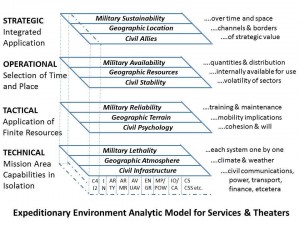
The Levels and Types of Intelligence
There are four levels of intelligence support — strategic, operational, tactical, and technical — within each level we should be doing encyclopedic and warning intelligence as well as tailored decision support while ensuring that we reconcile analysis and true costs among the levels and across all mission areas. Warning intelligence is explicitly something that must be do-able at all four levels — technical, tactical, operational, strategic — with persistence and deep excellence. We do not do warning intelligence today with any degree of coherence, comprehensiveness, or reliability.
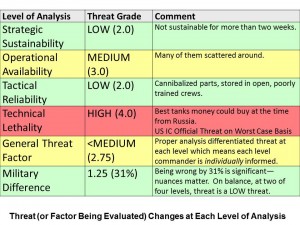
The threat changes depending on the level of analysis as well as the time and place where the threat is encountered.At the same time, strategic mis-steps can gut tactical campaigns, and vice versa (a classic example of this is the LBJ White House providing the aviation target list to NVN a day in advance, after picking the targets and before they were relayed to our own forces).
Commanders and their staffs must be able to think at all four levels simultaneously, and within each level, across all civil and geographic domains, not only the military domain.
It is essential that intelligence and leadership be holistic across the levels. The commander needs to have a G-2 that is able to support his strategic impact (understand when others are providing false information), operational cohesion (drawing in all necessary partners), tactical effectiveness (vastly improve drone-assisted real-time targeting for artillery as well as current 1:50 combat charts with all existing cultural features), and technical procurement (back away from expensive complexity and contractors in the field, figure out how to pull energy and water out of the air on the fly).
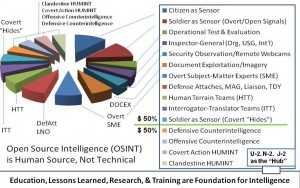
The Sources of Intelligence
We have gone nuts on technical collection (both signals and imagery), and refuse to be serious about indigenous minds and eyes and ears and the 90% of the information that is not online, not in English, and not known to Washington. Wrong turns include the neglect of operational and tactical wide area surveillance in favor of precision imaging against Soviet missile silos; the gutting of tactical aerial reconnaissance and the complete disregard for the human factor in intelligence; and the refusal to invest in tools for thinking, focusing instead on collection that is not processed. It is not helpful that we still do not have current 1:50,000 combat charts for most of the world, meaning that all cultural artifacts built (or destroyed) in the past several decades do not appear on the electronic charts we are given, and we do not have ready access to printed charts that can be shared with foreign partners.
All sources are human sources. Period. Technology as implemented by the US IC and distorted by the USAF love for all things tecnical, is an obstacle to thinking and not worth what we pay for it. At the same neither CIA nor the military are serious about HUMINT — clandestine HUMINT is in the toilet and all forms of overt HUMINT are haphazard at best. The atmospherics, the feeling in the fingertips, the early warning of plans & intentions are all done faster, better, and cheaper with HUMINT instead of TECHINT.

There is an opening for a “lifeboat” that explores a bottom-up reinvention of intelligence characterized by austere alternative C4I that enables rapid secure (but not necessarily secret) information-sharing and sense-making across Whole of Government (inter-agency) and across multinational coalitions inclusive of private sector elements — the “eight tribes” that include LOCAL academia, LOCAL civil society labor unions and religions, LOCAL commerce, LOCAL government, LOCAL law enforcement, LOCAL media and bloggers, LOCAL gendarme and military, and LOCAL non-government and non-profit organizations (and of course national, regional, and global as well). This is where the recent emergence of the 1st Special Operations Command may yield an innovation opportunity.
Missing from our futures planning is a concept for achieving three things: an alternative C4I system that is open to all eight of the information tribes while providing security (not necessarily secrecy); an open source analytic workstation that can be given away free on a flash drive; and a virtual “world brain” in the cloud, geospatially grounded enabling near real time information-sharing and sense-making across all cultures, histories, languages, and socio-economic boundaries while protecting anonymity, privacy, rights, and security parameters established by the owners of each bit of information.
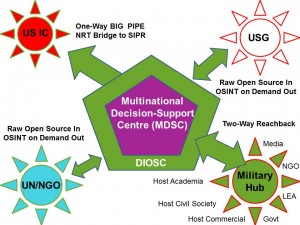
Ultimately intelligence with integrity is multinational and multiagency in nature. A web of sources becomes indistinguishable from a web of consumers and producers of intelligence. Of course there must be unilateral secret intelligence and counterintelligence but the greatest value of intelligence with integrity is in the application, and only multinational multiagency applications stand the test of time.

Very specifically, intelligence with integrity can resolve all of the UN Sustainable Development Goals (SDG) within a fraction of the time at a fraction of the price of the dysfunctional system we have now that is easily 50% waste and incapable of creating a prosperous world at peace [which, by the by, stops all the illegal immigrants from flooding into AU, EU, and US].
In my view, the military is ideally suited to the establishment of this global network with national eight tribe centers operated by the military — by with and through is ultimately about shared situational awareness, shared information, shared combined action decision-making. The US IC as structured and managed today is of very limited utility — on the order of 4% according to one celebrated war commander — to military and civilian success at all levels.
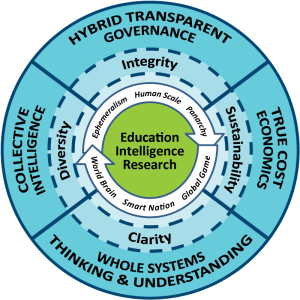
The Cost of Intelligence
80% of what we need to know can be found (we already know it), gotten (we know who knows) or bought (commercial acquisition) at a cost of less than 5% of what we spend on secret collection today. Building on the Global Coverage estimate of Keith Hall as elicited by Boyd Sutton, I have twice obtained OMB approval for an Open Source Agency at IOC $125M toward FOC $2B — today because I have radically increased its scope to include an Open Source Technologies Bureau in addition to an Open Source Information Bureau, I propose $5B FOC as the objective. Add to that $5B for a National Counterintelligence Organization (NCO) able to do undetectable persistent human surveillance all over the world, $10B earmarked for all forms of HUMINT other than offensive and defensive counterintelligence, $20B for precision TECHINT (more drones and cyber than satellites) inclusive of real-time geospatially-based processing, and $20B for at least seven multinational multiagency decision-support centres and networks worldwide, and you get $60B as the target. The greatest cost we pay is the opportunity cost of failing to treat intelligence — along with education and research — as the foundation for peace and prosperity for everyone at home and abroad.
NEW BOOKS:
Click to see all Steele books in print, most recent first.
Selected past publications (20200303 Broken SSI Links Repaired):
Steele, Robert. “On Defense Intelligence: Seven Strikes,” CounterPunch, July 2, 2014.
Steele, Robert. “The Evolving Craft of Intelligence,” in Robert Dover, Michael Goodman, and Claudia Hillebrand (eds.). Routledge Companion to Intelligence Studies, Oxford, UK: Routledge, July 31, 2013.
Steele, Robert (2010). Human Intelligence: All Humans, All Minds, All the Time, Carlisle, PA: Strategic Studies Institute, U.S. Army War College, Press, June 3, 2010.
Steele, Robert. “Open Source Intelligence (Strategic),” in Loch Johnson (ed.), Strategic Intelligence: The Intelligence Cycle, Westport, CT: Praeger, 2007, Chapter 6, pp. 96-122.
Steele, Robert (2006). Information Operations: Putting the “I” Back Into DIME, Carlisle, PA: Strategic Studies Institute, U.S. Army War College, Press, February 1, 2006.
Steele, Robert (2002). The New Craft of Intelligence: Achieving Asymmetric Advantage in the Face of Nontraditional Threats, Carlisle, PA: Strategic Studies Institute, U.S. Army War College, Press, February 1, 2002.
Steele, Robert. “SPECIAL FEATURE: Creating a Smart Nation–Strategy, Policy, Intelligence, and Information,” Government Information Quarterly, pp. 159-173
Steele, Robert. “Intelligence Support for Expeditionary Planners,” Marine Corps Gazette, September 1991, pp. 73-79.
Steele, Robert. “Applying the ‘New Paradigm’: How to Avoid Strategic Intelligence Failures in the Future,” American Intelligence Journal, Autumn 1991, pp. 43-46.
Steele, Robert. “Intelligence in the 1990’s: Recasting National Security in a Changing World,” American Intelligence Journal, Summer/Fall 1990, pp. 29-36.
Gray, Al (Ghost-Written by Robert Steele), “Global Intelligence Challenges in the 1990’s,” American Intelligence Journal, Winter 1989-1990, pp. 37-41.
See Also:
All Appearances and Publications by Robert Steele



